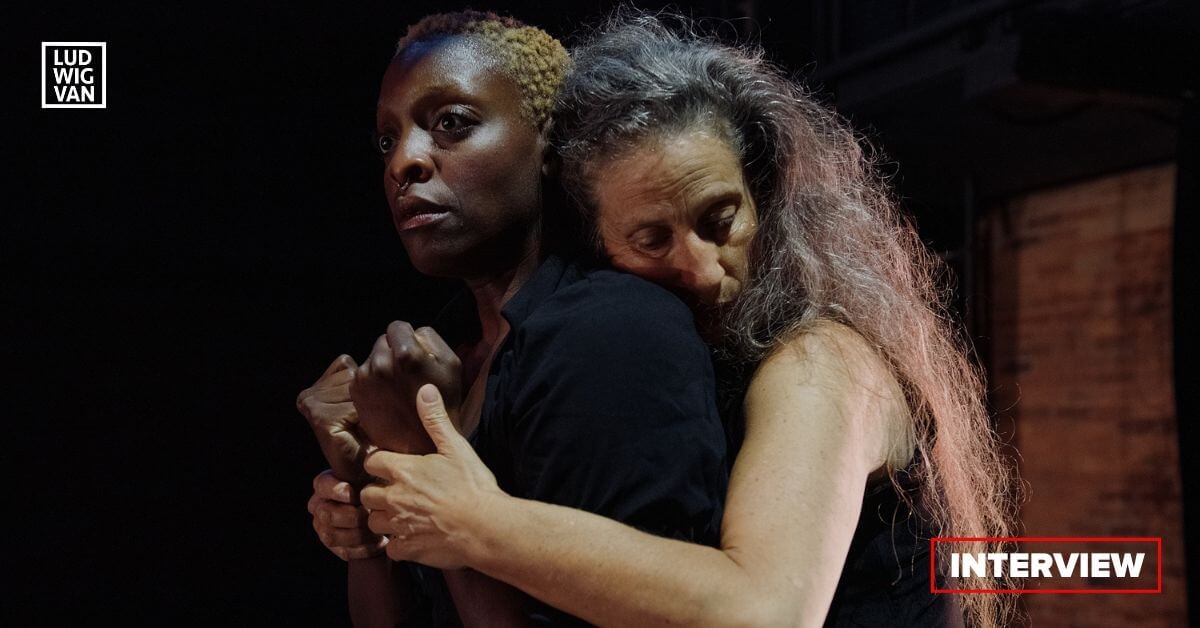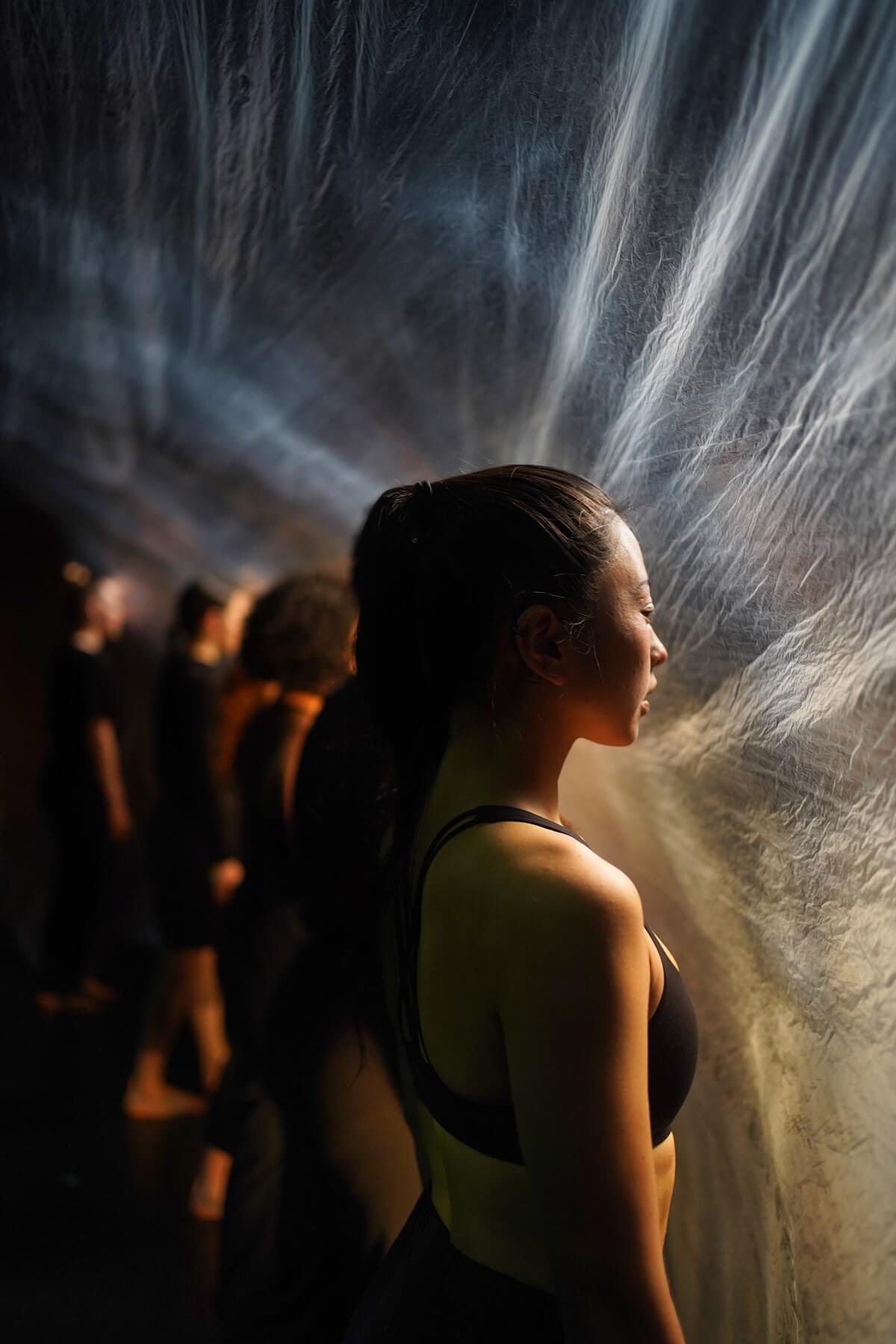
Harbourfront Torque Dance Series & Kaeja d’Dance/31 (TouchX + I am the Child of…), choreography by Karen and Allen Kaeja, Harbourfront Centre Theatre, Nov. 11 to 13. Tickets here.
Founded in 1990, Kaeja d’Dance is one of Toronto’s most enduring contemporary dance companies. Although co-artistic directors Karen and Allen Kaeja are in their 60s, they have never stopped looking forward, as their joint Harbourfront show demonstrates.
Karen has been working on her new piece TouchX for seven years, and key to the fabric of the work is the participation of everyday members of the community, along with professional dancers and students from the graduating class of School of Toronto Dance Theatre.
Allen has collaborated with Bruce Barton (Vertical City) to go high tech. His I am the Child of… features augmented reality (AR) and livecam footage which affords the audience the opportunity to view the show from their cell phones through a QR code, or through the dancers’ body cameras.
As Karen states, “My piece has the humans; Allen has the tech.”
The four of us (Karen, Allen, Barton and myself) had a long Zoom call to try to unpack the structure of this complex dance evening. In my case, it was coming to grips with the latest offering of the always surprising Kaejas.
What follows is a distillation of my many questions.
How did Kaeja d’Dance end up on Harbourfront’s Torque series — one of the most prestigious in the city?
The answer, it turns out, is simple. Karen wrote an email to Nathalie Bonjour, Harbourfront’s Director of Performing Arts, explaining that she was working on a piece that included both community and professional dancers, and that she wanted Bonjour to know about it. In the conversation that followed, Bonjour found out about Allen’s foray into AR, and the joint evening blossomed from there.
Says Karen, “It’s a very expensive show, and having Harbourfront as a sponsor definitely helped. I wouldn’t be in this state of calm without them.”
Allen adds, “Harbourfront has never given two residencies to the same company before, and it was a gift, because they were technical residencies where we worked with their expertise to support our visions. We got to see how the set, lighting, costumes and bodies worked in the theatre space. We could troubleshoot the complexities of the pieces.”
Karen Kaeja on her piece ‘TouchX’
I came late to dance — I was 18 — and what fascinated me was bodily contact — how people physically connect — and this exploration has consumed my whole dance career.
I made a Dora Award-winning duet in 2012 called Crave that investigated the concept of touch, the implications and complications of connection, and I wanted to add on a new layer to the work — combining both professional and community dancers.
I really wanted to have 100 people in the piece but COVID ended that idea. TouchX has 36 participants — 8 professional dancers, 8 graduating students from School of TDT, and 20 community dancers. The students and the community performers bring a whole different feel to the piece.
Pre-pandemic, the dancers were asked what had touched them the most in their lives, and then they created their own gestures to express this. The key was to immerse everyone in each other’s dance culture. During the pandemic, I could only work on solos in my backyard. The pandemic added new challenges and juxtapositions to the meaning of touch. For example, how do we feel about being touched after Covid?
Most of the community dancers are older, and I chose this age group, because as I age, I realize that the body and mind contain much history that I want to explore — how movement changes over time, as does the range of touch and connection.
My composer, Gregory Harrison, took some of my writing and turned it into a libretto with live singing. My designer, Sonja Rainey created a brilliant landscape made from transparent fabric that is like a metaphor — this material layer that we have to see through, like another skin.
Sonja and I worked with imagery that conveyed ice, glaciers, desolation, coldness, numbness, transparency, layers of meaning. It’s a very big set.
The work comes from deep within me, concepts that I have been working with my whole life.
I had so many modules, as I call them, that TouchX could have lasted for 7 days, but I had to cut it down to 50 minutes.
Allen and Bruce Barton talk about the background for ‘I am the Child of…’
For point of reference, Barton, 64, is the Director of the School of Creative and Performing Arts (dance, drama, music) at the University of Calgary. His company, Vertical City, founded in 2007, specializes in interdisciplinary performance and research/creation. This is the fifth time he has collaborated with Allen Kaeja with an emphasis on productions that are immersive within creative environments.
The concept for I am the Child of… was sparked during the 2015 election campaign by then Conservative leader Stephen Harper, who said he wasn’t going to meet with the other leaders over the Syrian refugee crisis. Yet, the entire nation had been moved by the dead little Syrian boy who had been washed up on the shore when his boat sank.
This led Allen to react to the fact that he was the child of a refugee — a Holocaust survivor who had lost his wife and child, and who had spent time in a refugee camp. When his dad’s cousin in Canada wrote to him after the war, he told him, “Don’t come here because they don’t want our kind”, but Allen’s father came anyway, and made a good life for himself. He was so loved that he was made an honorary police officer. “That’s what refugees do,” says Allen. “They make a new life.”
Allen wanting to explore refugees and their stories, and how these stories interact. He asked his eight dancers to begin by writing down their memories, which provided multiple perspectives. The company did two residencies at Banff where these many pages of memories were reduced down to one memory of 150 words for each dancer. As well, they each had to choose a song from their childhood.
Says Barton, “My interest is in physical dramaturgy, which fits in well with Allen’s choreography that is always very formal, very physical and very athletic. I took the writings and refined them to create a textual environment. Composer Edgardo Moreno recorded the dancers’ voices and the songs, and created a soundscape for the piece.”

The high tech component of ‘I am the Child of….’
There are eight dancers and five augmented reality (AR) dancers. The five AR dancers come from the eight. Like Karen, Allen chose dancers who spanned a whole range of ages, from their 20s to 60s. He also chose Karen, who is a dancer in I am the Child of…
The AR component grew out of an experiment. When the pandemic hit, Allen and Barton got a grant from Artworkx TO, which was an initiative designed to create neighbourhood art. Dancers performed choreography in a laneway that was filmed. Viewers in their homes could see the dance by scanning a QR code on their phone.
This led Barton and Allen to go one step further. At the actual theatre performance of I am the Child of… an audience member can scan a QR code and see an AR dancer in reality, and not in a film. Explains Barton, “It’s a whole new architecture of performance. Audiences can watch the live and perceived dancer interact together. This leads to the question — what is the deeper meaning of technology?”
The result is the first interactive AR dance production in Canada, thanks to Toaster Lab, the company that created the AR component. The avatar dancers were animated in space by filming them before a green screen. When audience members scan a QR code, four squares appear on their screen, and clicking on each square gives them a different viewpoint of the performance.
“AR figures cannot be projected on a wall. You need to see them on a phone or an iPad by scanning a QR code,” Allen says.
Barton adds, “This is a performance where cell phones are welcome.”
As the men describe the process, you can play with scale by making an avatar life-size, or smaller, or larger. They are not a novelty, however. Rather, the AR dancers are integrated thematically into the performance, and so add to the concept of how we perceive each other.
Thus, there are three different ways audiences can immerse themselves in the performance. They can see the AR dancers perform with their live selves. They can follow the performance through the dancers’ eyes through their livestream bodycams, or they can simply watch the stage performance.
“We were interested in creating a multi-perspective performance,” says Allen, “and the audience has agency. They can choose just how immersive they want to be.”
Not to be forgotten, however, is that each dancer is performing their own story which includes aspects of their own childhood. The memories range from the benign — getting a new pair of roller blades — to the traumatic — child abuse. The dancers collectively form a rich community of memories.
The men have also thrown a structured improvisation component into the 38-minute work. An hour before the show begins, the dancers pull a series of prompts out of a hat that, for a certain section of the performance, tells them who they will be dancing with, what physical process they will use, and the underlying emotion of the meeting.
How do the Kaejas and Barton see the two pieces working together?
Inter-relationships are mentioned, as is the presence and absence of innocence, of perception, of presence. Questions raised include: How do we see ourselves and others.? How do we respond to people? How do we live our lives?
Says Karen, “The pieces are a celebration of humanity, but we’re not sweeping struggle under a rug.”
“We’re here to honour and respect those voices, to listen and respond, but not to create judgment,” Allen adds.
“The works represent a hybrid. On one hand there is face to face communication, on the other is technology, and life through a screen,” says Barton.
What does Kaeja d’Dance stand for as a company?
From Barton: “Kaeja d’Dance is unique because it is driven by the two very different personalities of a married couple who are savvy, intelligent, and willing to take risks. They have a deep investment in what experimentation means without seeing it as a trend or novelty. They have survived for 30 years through force of will and imagination.”
From Karen: “The support between the two of us has been an unbelievable journey. We’ve allowed each other to follow our own fascinations. It has not been without its challenges, however. The flowers are always blossoming, but some die.”
From Allen: “Why be ahead of the curve, when you can create the curve?”
#LUDWIGVAN
Get the daily arts news straight to your inbox.
Sign up for the Ludwig van Daily — classical music and opera in five minutes or less HERE.
- INTERVIEW | Actor Diego Matamoros Takes On Icon Walt Disney In Soulpepper Production Of Hnath Play - April 16, 2024
- SCRUTINY | Opera In Concert Shine A Light On Verdi’s Seldom Heard La Battaglia Di Legnano - April 9, 2024
- SCRUTINY | Lepage & Côté’s Hamlet Dazzles With Dance And Stagecraft Without Saying Anything New - April 5, 2024



